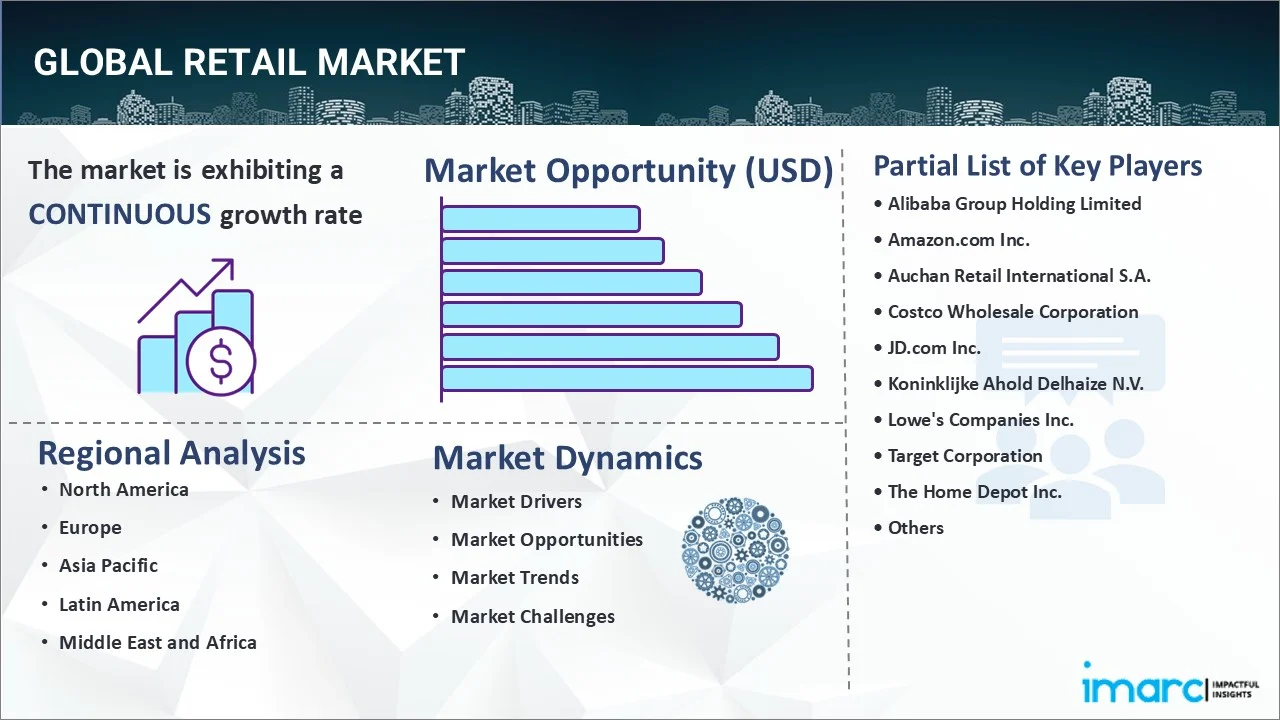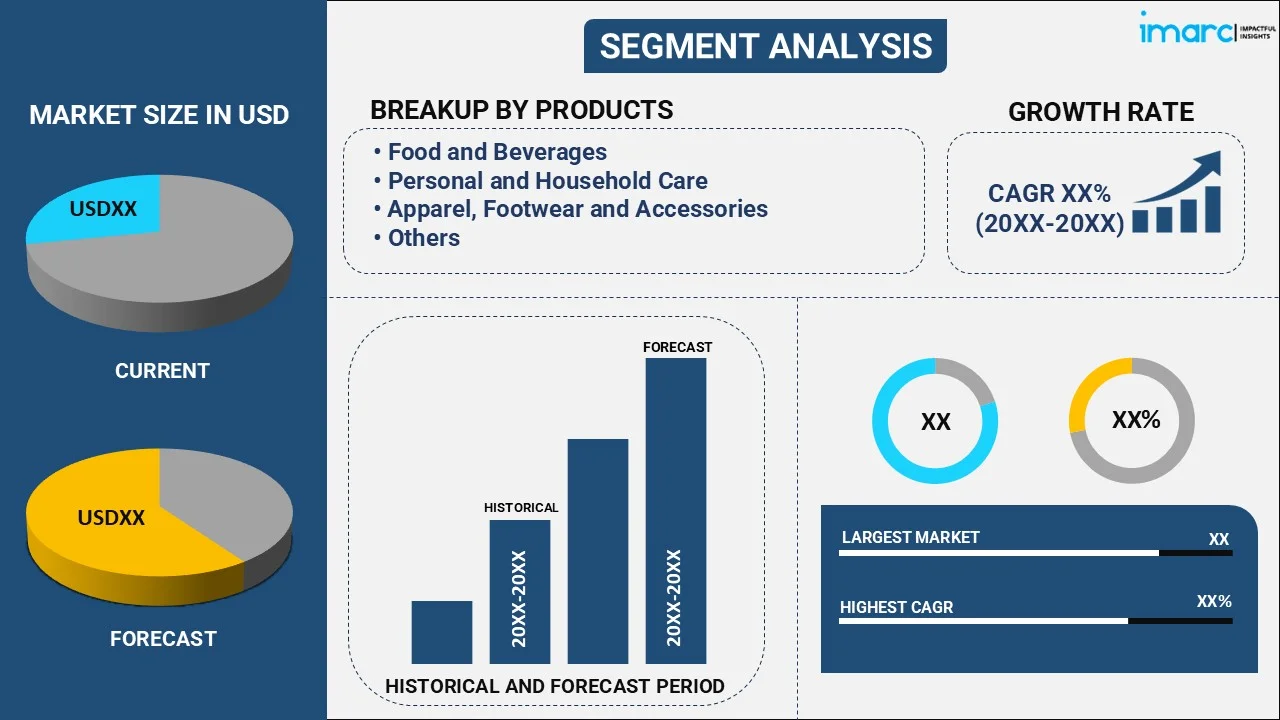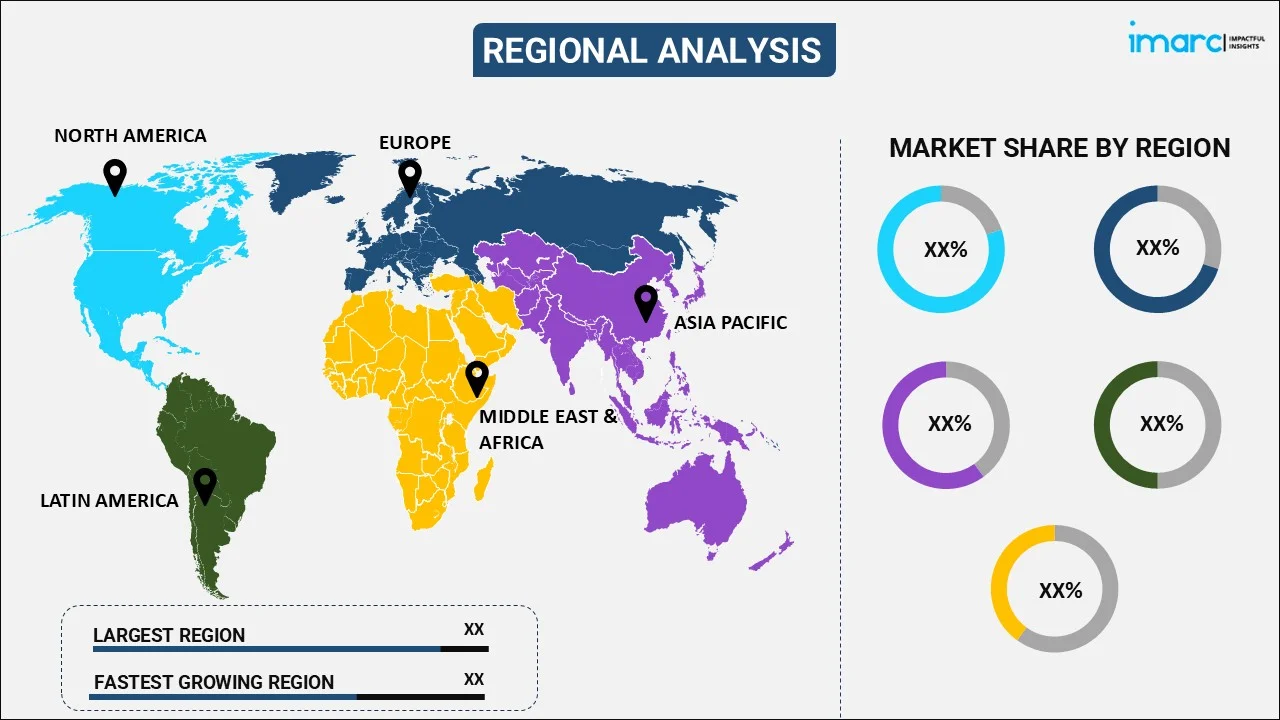
Retail Market Report by Product (Food and Beverages, Personal and Household Care, Apparel, Footwear and Accessories, Furniture, Toys and Hobby, Electronic and Household Appliances, and Others), Distribution Channel (Supermarkets and Hypermarkets, Convenience Stores, Specialty Stores, Online Stores, and Others), and Region 2025-2033
Retail Market Overview:
The global retail market size reached USD 30,092.3 Billion in 2024. Looking forward, IMARC Group expects the market to reach USD 48,867.9 Billion by 2033, exhibiting a growth rate (CAGR) of 5.26% during 2025-2033. There are various factors that are driving the market, which include the rising focus on personalized user experience, technological innovations, and various collaborations and partnerships among key players to expand their market reach and increase user engagement.
|
Report Attribute
|
Key Statistics
|
|---|---|
|
Base Year
|
2024 |
|
Forecast Years
|
2025-2033
|
|
Historical Years
|
2019-2024
|
| Market Size in 2024 | USD 30,092.3 Billion |
| Market Forecast in 2033 | USD 48,867.9 Billion |
| Market Growth Rate (2025-2033) | 5.26% |
Retail Market Analysis:
- Major Market Drivers: One of the key market drivers includes improving supply chain management and logistics. Moreover, there is an increase in cross-border trade, which is acting as another growth-inducing factor.
- Key Market Trends: The rising focus on personalized user experience and technological innovations are main trends in the market.
- Geographical Trends: Asia Pacific exhibits a clear dominance, accounting for the biggest market share owing to rapid urbanization.
- Competitive Landscape: Major market players in the retail industry are Alibaba Group Holding Limited, Amazon.com Inc., Auchan Retail International S.A., Costco Wholesale Corporation, JD.com Inc., Koninklijke Ahold Delhaize N.V., Lowe's Companies Inc., Target Corporation, The Home Depot Inc., The Kroger Co., The Schwarz Group, Walgreens Boots Alliance Inc., Walmart Inc., among many others.
- Challenges and Opportunities: Changing consumer behavior represents a key market challenge. Nonetheless, the increasing focus on sustainability and ethical practices, coupled with the rising need for digital payment solutions, is projected to overcome these challenges and provide market opportunities.

Retail Market Trends:
Rising Focus on Personalized User Experience
There is an increase in the emphasis on tailored user experiences. Retailers can get a vast amount of data from a variety of sources like past purchases, social media interactions, browsing histories online, and in-store behavior easily. By cross-selling related products and up-selling higher-value items, personalized recommendations benefit in increasing average order value. Personalized greetings, loyalty programs, and tailored services based on user data can be utilized to develop individualized experiences in physical locations, which is offering a positive retail market outlook. Leading companies are concentrating on offering better services to enhance user satisfaction. For instance, Tata Consultancy Services (TCS) launched TCS Customer Intelligence & Insights (CI&I) for Retail 3.0 on January 19, 2023, to help retailers deepen their relationships with clients. This offers hyper-personalized engagement at every point of the user journey. At key physical and digital touchpoints, the software generates insights, predictions, and recommended actions, resulting in higher returns on marketing investments and user satisfaction.
Technological Innovations
The rising adoption of advanced technologies like artificial intelligence (AI) and machine learning (ML) is impelling the retail market growth. AI algorithms examine user data to offer tailored product recommendations that aid in increasing user satisfaction. Chatbots with AI capabilities respond to client questions and offer product details. Augmented reality (AR) enables users to digitally try on clothing, accessories, and makeup that benefit in improving the online shopping experience of individuals worldwide. People can explore virtual stores and products from the comfort of their homes using virtual reality (VR). In line with this, big data analytics is used by retailers to understand user behavior, preferences, and trends, which helps them create marketing campaigns more successful. Additionally, retail companies are collaborating with other businesses to provide consumers advanced services. For example, on January 10, 2023, Microsoft and AiFi, a startup that helps businesses deploy autonomous shopping technologies at a reasonable cost, collaborated to unveil its cloud service ‘Smart Store Analytics’. A part of Microsoft’s Cloud for retail product suite, smart store analytics provides retailers using AiFi’s technology with shopper and operational analytics for their fleets of ‘smart stores’.
Various Partnerships and Collaborations Among Key Players
Various partnerships and collaborations among major players are catalyzing the retail demand. Retailers in the market are collaborating with tech companies to improve their online presence. Working together with payment technology providers or AI companies to provide tailored shopping experiences helps in offering seamless transaction solutions. Apart from this, companies are focusing on creating exclusive lines of goods by frequently using their complementary advantages. Furthermore, market players are forming partnerships to improve the shopper experience. For instance, on 4 May 2023, Auchan Retail partnered with Trigo, the Israel-based computer vision company specializing in frictionless checkout technology and retail analytics, to launch an autonomous grocery store for the French retail group’s head office employees. Auchan’s new Go store will enable a tap-and-go experience where shoppers can tap their credit or debit card on the entrance gate.
Retail Market Segmentation:
IMARC Group provides an analysis of the key trends in each segment of the market, along with forecasts at the global, regional, and country levels for 2025-2033. Our report has categorized the market based on product and distribution channel.
Breakup by Product:

- Food and Beverages
- Personal and Household Care
- Apparel, Footwear and Accessories
- Furniture, Toys and Hobby
- Electronic and Household Appliances
- Others
Food and beverages account for the majority of the market share
The report has provided a detailed breakup and analysis of the market based on the product. This includes food and beverages, personal and household care, apparel, footwear and accessories, furniture, toys and hobby, electronic and household appliances, and others. According to the report, food and beverages represented the largest segment.
Food and beverages are necessities that people buy on a regular basis. Staple food items like bread, milk, fruits, vegetables, and meat encourage regular purchases. People who lead hectic lives are becoming more and more in need of easily available and convenient food and beverage options. Furthermore, the trend towards healthy eating, organic products, and beverages that promote wellness is expected to offer a positive retail market forecast.
Breakup by Distribution Channel:
- Supermarkets and Hypermarkets
- Convenience Stores
- Specialty Stores
- Online Stores
- Others
Supermarkets and hypermarkets hold the largest share of the industry
A detailed breakup and analysis of the market based on the distribution channel have also been provided in the report. This includes supermarkets and hypermarkets, convenience stores, specialty stores, online stores, and others. According to the report, supermarkets and hypermarkets account for the largest market share.
Supermarkets and hypermarkets provide a wide range of goods including food, apparel, electronics, and home furnishings, all under one roof. An expanded consumer base is drawn in by this extensive product line. People enjoy the ease of one-stop shopping since these channels allows them to conveniently get whatever they need in a one trip. These distribution channels also give a range of special offers, loyalty plans, and promotions to attract price-sensitive individuals.
Breakup by Region:

- North America
- United States
- Canada
- Europe
- Germany
- France
- United Kingdom
- Italy
- Spain
- Others
- Asia Pacific
- China
- Japan
- India
- South Korea
- Australia
- Indonesia
- Others
- Latin America
- Brazil
- Mexico
- Others
- Middle East and Africa
Asia Pacific leads the market, accounting for the largest retail market share
The report has also provided a comprehensive analysis of all the major regional markets, which include North America (the United States and Canada); Europe (Germany, France, the United Kingdom, Italy, Spain, and others); Asia Pacific (China, Japan, India, South Korea, Australia, Indonesia, and others); Latin America (Brazil, Mexico, and others); and the Middle East and Africa. According to the report, Asia Pacific represents the largest regional market for retail.
The rising demand for retail stores due to rapid urbanization in the Asia Pacific region is impelling the market growth. In addition, the ease of internet facilities and utilization of smartphones, are propelling the market growth. Besides this, the development of secure and convenient digital payment systems is contributing to the market growth. Furthermore, top market players in the region are focusing on expanding their market reach by opening new facilities. For instance, on 24 August 2023, India’s largest retailer, Reliance Retail announced the launch of its youth-focused fashion retail format, Yousta with the opening of its first store in Hyderabad’s Sarath City Mall. With contemporary tech-enabled store layouts, Yousta offers high-fashion at affordable prices targeted at young consumers.
Competitive Landscape:
- The market research report has also provided a comprehensive analysis of the competitive landscape in the market. Detailed profiles of all major companies have also been provided. Some of the major market players in the retail industry include Alibaba Group Holding Limited, Amazon.com Inc., Auchan Retail International S.A., Costco Wholesale Corporation, JD.com Inc., Koninklijke Ahold Delhaize N.V., Lowe's Companies Inc., Target Corporation, The Home Depot Inc., The Kroger Co., The Schwarz Group, Walgreens Boots Alliance Inc., and Walmart Inc.
(Please note that this is only a partial list of the key players, and the complete list is provided in the report.)
- Key players in the market are focusing on investing in online shopping platform and digital infrastructure. They are using advanced technologies such as AI, machine learning, and blockchain to enhance supply chain efficiency, personalize user experiences, and improve inventory management. They are also reducing their carbon footprint through renewable energy projects, waste reduction programs, and sustainable product sourcing to increase their retail market revenue. Furthermore, companies are engaging in partnerships to provide a wide range of products to end users. For example, on 16 August 2023, Gucci and JD.com announced a digital partnership and the highly anticipated launch of the official Gucci digital flagship store on the e-commerce leader's platform. Users searching for "Gucci" within the JD.com app will be invited to explore the House's official flagship store and shop for their favorite items. This will also include a full range experience of Gucci brand services, all within a seamless and secure digital ecosystem.
Retail Market Recent Developments:
- 7 May 2024: Amazon launched its online marketplace in South Africa. The launch has been highly anticipated since Amazon announced its plans to expand into South Africa in October 2023. The retailer's services were already available locally via the international platform, but purchases included hefty import duties on products shipped from international depos.
- 2 March 2023: Walmart planned to expand its network of medical centers in 2024. This will expand Walmart Health’s footprint into two new states ‘Missouri and Arizona’ and deepen its presence in Texas.
- 19 September 2023: Uber and Oracle announced a partnership to enable the thousands of retailers and other brands that run on Oracle Retail applications to use the Uber Direct on-demand shipping platform to facilitate hassle-free product deliveries and returns. Under the joint service, called Collect and Receive, these Oracle clients can now seamlessly introduce on-demand delivery services integrated with their e-commerce, point-of-sale, procurement, customer relationship management, merchandising, inventory planning, distribution, and restocking systems.
Retail Market Report Scope:
| Report Features | Details |
|---|---|
| Base Year of the Analysis | 2024 |
| Historical Period | 2019-2024 |
| Forecast Period | 2025-2033 |
| Units | Billion USD |
| Scope of the Report | Exploration of Historical Trends and Market Outlook, Industry Catalysts and Challenges, Segment-Wise Historical and Future Market Assessment:
|
| Products Covered | Food and Beverages, Personal and Household Care, Apparel, Footwear and Accessories, Furniture, Toys and Hobby, Electronic and Household Appliances, Others |
| Distribution Channels Covered | Supermarkets and Hypermarkets, Convenience Stores, Specialty Stores, Online Stores, Others |
| Regions Covered | Asia Pacific, Europe, North America, Latin America, Middle East and Africa |
| Countries Covered | United States, Canada, Germany, France, United Kingdom, Italy, Spain, China, Japan, India, South Korea, Australia, Indonesia, Brazil, Mexico |
| Companies Covered | Alibaba Group Holding Limited, Amazon.com Inc., Auchan Retail International S.A., Costco Wholesale Corporation, JD.com Inc., Koninklijke Ahold Delhaize N.V., Lowe's Companies Inc., Target Corporation, The Home Depot Inc., The Kroger Co., The Schwarz Group, Walgreens Boots Alliance Inc., Walmart Inc., etc. |
| Customization Scope | 10% Free Customization |
| Post-Sale Analyst Support | 10-12 Weeks |
| Delivery Format | PDF and Excel through Email (We can also provide the editable version of the report in PPT/Word format on special request) |
Key Benefits for Stakeholders:
- IMARC’s industry report offers a comprehensive quantitative analysis of various market segments, historical and current market trends, market forecasts, and dynamics of the market from 2019-2033.
- The research report provides the latest information on the market drivers, challenges, and opportunities in the global market.
- The study maps the leading, as well as the fastest-growing, regional markets. It further enables stakeholders to identify the key country-level markets within each region.
- Porter's five forces analysis assists stakeholders in assessing the impact of new entrants, competitive rivalry, supplier power, buyer power, and the threat of substitution. It helps stakeholders to analyze the level of competition within the retail industry and its attractiveness.
- The competitive landscape allows stakeholders to understand their competitive environment and provides insight into the current positions of key players in the market.
Key Questions Answered in This Report
The retail market was valued at USD 30,092.3 Billion in 2024.
The retail market is projected to exhibit a CAGR of 5.26% during 2025-2033, reaching a value of USD 48,867.9 Billion by 2033.
The retail market is driven by technological advancements, such as AI and omnichannel integration, which enhance customer experiences and streamline operations. Consumer preferences are also shifting toward personalized, convenient shopping options, including mobile commerce and sustainable products. Additionally, economic growth and urbanization expand market reach.
Asia Pacific currently dominates the retail market, driven by rapid urbanization, rising middle-class incomes, and expanding internet access. Growing e-commerce adoption, especially mobile shopping, fuels convenience and personalization demands. Retailers’ integration of omnichannel strategies and smart technologies enhances consumer experiences, positioning the region as a key hub for global retail growth and innovation.
Some of the major players in the retail market include Alibaba Group Holding Limited, Amazon.com Inc., Auchan Retail International S.A., Costco Wholesale Corporation, JD.com Inc., Koninklijke Ahold Delhaize N.V., Lowe's Companies Inc., Target Corporation, The Home Depot Inc., The Kroger Co., The Schwarz Group, Walgreens Boots Alliance Inc., Walmart Inc., etc.
Need more help?
- Speak to our experienced analysts for insights on the current market scenarios.
- Include additional segments and countries to customize the report as per your requirement.
- Gain an unparalleled competitive advantage in your domain by understanding how to utilize the report and positively impacting your operations and revenue.
- For further assistance, please connect with our analysts.
 Request Customization
Request Customization
 Speak to an Analyst
Speak to an Analyst
 Request Brochure
Request Brochure
 Inquire Before Buying
Inquire Before Buying




.webp)




.webp)












